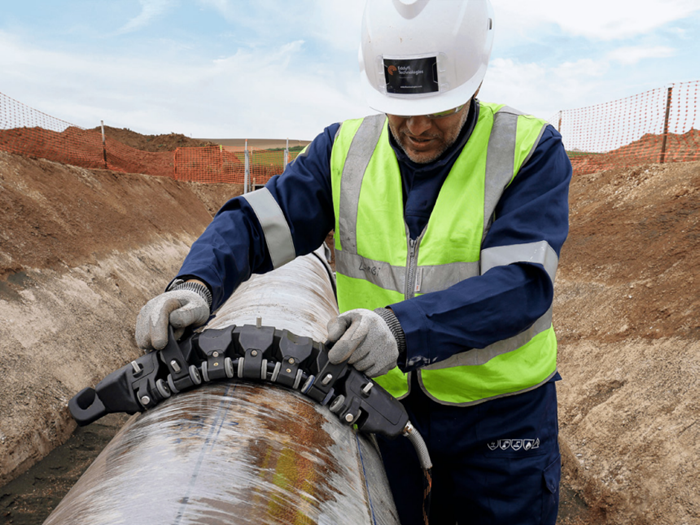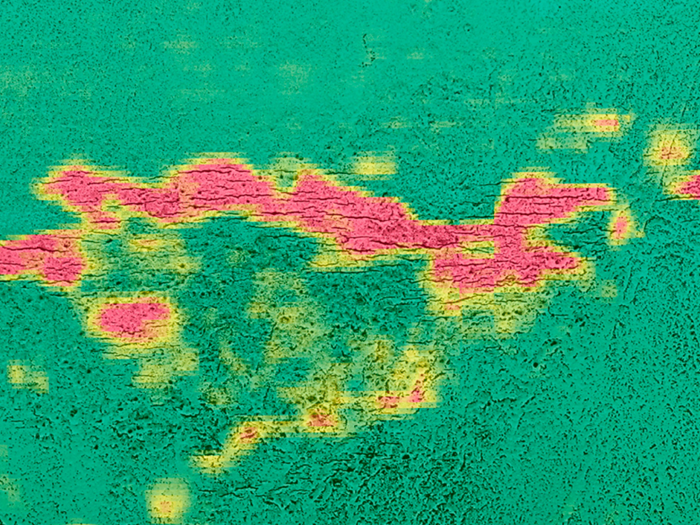Assessing Emulsion Pipelines... in the Digital Age
An emulsion pipeline essentially carries a mixture of bitumen, hot water and steam. Unfortunately, this critical asset is subject to various damage mechanisms, among which cracking (including stress-corrosion cracking) is one of the most prevalent and known to be one of the main causes of pipeline incidents.
To properly mitigate risks, a North American pipeline owner needed a long section of emulsion pipeline to be inspected. After having considered performing Magnetic Particle Inspection (MPI)—the de facto method for pipeline direct examination—a number of reasons led the decision makers to opt for an alternative, digital method.
The Challenge
- Inspecting a 32 km (20 mi.) long emulsion pipeline at 150°C (300°F) to detect cracks in the safest and most efficient way possible.
Inspecting a 24 inch diameter pipeline over a 32 kilometre stretch is like scrutinizing an area equivalent to 12 football fields… and looking for a minute detail. The total area to be inspected is simply gigantic. Nonetheless, there is no room for errors (e.g., having a crack undetected) and the non-destructive testing examination must be reliable (from beginning to end) while remaining safe.
To make the inspection more difficult, the pipeline surface was hot (150°C), pointing towards dry MPI as a first NDT screening technique. However, MPI has a fair amount of limitations or drawbacks. Indeed, dry MPI is a long inspection process, so inspecting 32 kilometres with this technique would have taken an incredible amount of time. It also requires extensive surface preparation (e.g., exhaustive sandblasting and careful painting as proper contrast is key with this technique). Moreover, it is inevitably impacted by weather, environmental conditions, and outside temperature.
In addition to these limitations, one must recognize that MPI is always subject to the human factor. Virtually all steps of an MPI inspection procedure heavily rely on the operator: surface preparation, magnetization, interpretation, and reporting. Although extremely useful in a wide variety of contexts, MPI is intrinsically subject to the human factor, which impacts the repeatability of the results. A striking example is certainly when trying to detect a very small crack under a pipeline after hours of manipulating a yoke in an inhospitable environment.
Indeed, after having considered dry MPI, it became obvious for the decision makers that this technique would require too much time and too many technicians and offers limited confidence in the inspection results. Being able to actually collect data, map results, and archive digital records were also key features only a digital inspection method could give.

The Solution
- An ultrafast, digital inspection with Spyne™, an Eddy Current Array (ECA) tool capable of mapping the entire pipeline surface.
As an alternative to dry MPI, the pipeline owner and inspection company decided to opt for Eddy Current Array (ECA), a digital, electromagnetic non-destructive testing technique that allows detecting surface cracking very efficiently, even in the presence of paint or coating. Eddyfi’s Spyne™ tool is certainly the ideal embodiment of ECA when it comes to long emulsion pipelines. With an unmatched coverage of 8 in. (200 mm) and a scanning speed that can reach 24 in/sec (600 mm/sec), the Spyne is the perfect tool to detect isolated cracks as small as 3 mm in length and 1 mm in depth, in addition to typical Stress-Corrosion Cracking (SCC) clusters encountered during direct assessment work. The high sensitivity of the tool combined with its ease of use and tolerance to elevated surface temperature are certainly key factors that led decision makers to select this NDT inspection.
The Spyne works in combination with Eddyfi Reddy®, a rugged portable ECA instrument with a large multi-touch screen displaying the color-coded maps (C-scans) generated by the tool. Since the Spyne features an encoder, all data is recorded with spatial referencing, so the cracks appearing on the screen can be accurately located on the actual pipeline.
Thanks to the assisted detection capabilities of Reddy, all crack-like indications are highlighted by the software so technicians can then confidently discriminate a crack from a spurious signal in order to undertake the most suitable action. At last, the solution provides on-the-spot reporting, thanks to a well-designed archivable screening report.

Benefits
- An improved probability of detection, considerable time saving, and all advantages of going digital (imaging, reporting, archiving, safety, repeatability and more).
Numerous blind tests and field trials have shown the Spyne compares favourably against MPI when it comes to detection of SCC on pipelines. Without a doubt, the tool is less operator-dependent and reduces the burden on the technicians (especially when facing non-ideal surface preparation), adverse weather conditions, or physically hard-to-reach-spaces (e.g., cramped under the pipeline).
The Spyne tool systematically led to the discovery of more SCC than MPI, in less time, with no increase in false positives, while providing complete digital records of the inspection.
The Probability of Detection (PoD) offered by the Spyne tool, along with the repeatability aspect of the technique and the full digital records (including archiving) are serious advantages over MPI.
In terms of inspection speed, the fact that ECA does not require extensive surface preparation is a significant time-saver. Adding into the equation the large coverage of the probe and the scanning speed it tolerates means that an ECA inspection such as this one is typically 2 to 5 times faster than MPI while offering a much greater data density.








